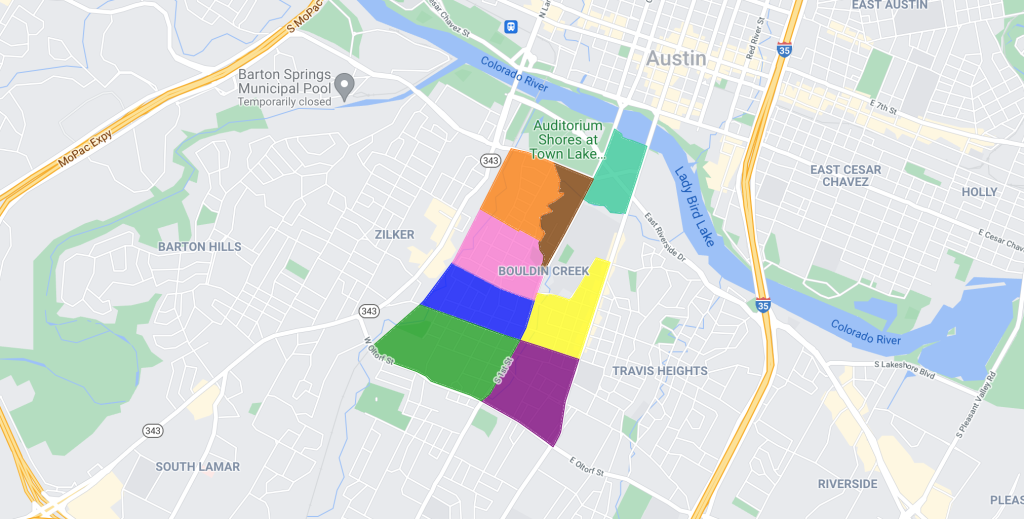About
Founded in 1981, the Bouldin Creek Neighborhood Association (BCNA) is one of the city’s oldest neighborhood associations. Today, the neighborhood contains over 5,600 residents and includes Auditorium Shores, The Long Center for the Performing Arts, and the Lester E. Palmer Community Events Center.
Bouldin Creek’s most unique assets are its residents. From its historic south-of-the-river, affordable bungalows, the neighborhood has become home to diverse cultural groups ranging from generations of home owners to new tenants; from old hippies to young techies. The result is an eclectic and vibrant mix of residents.
Boundaries
The Bouldin Creek neighborhood, as well as the BCNA, is bordered by Lady Bird Lake on the north, the Union Pacific Railroad Tracks on the west, Oltorf Street on the south, and South Congress Avenue on the east.

Communications
The BCNA reaches out to neighborhood residents by:
- Hosting General Association meetings, which are normally held at 6:45 PM on second (2nd) Tuesday every third (3rd) month. Past Minutes and those Pending approval are available for review.
- Encouraging residents to join the BCNA e-mail list
- Publishing the Bouldin Bulletin, our periodic neighborhood newsletter. Electronic copies of the Bouldin Bulletin are available.
Bylaws
To learn more about how the BCNA operates, consult the current bylaws
Bouldin Creek Neighborhood Plan
Over the span of a couple of years in the late 1990s Bouldin Creek residents, together with other stakeholders and city planning staff, embarked on an extensive collaborative process to collectively envision our neighborhood. The result, adopted by City Council in 2002, is the Bouldin Creek Neighborhood Plan (NP), a living, evolving document that charts stakeholder values and future land use through a city-proscribed process.
See the Bouldin Creek Neighborhood Plan Contact Team (BCNPCT) bylaws
Schools:
Becker Elementary is the home elementary school for a large portion of the neighborhood, and some of the area contributes to Travis Heights Elementary. Lively Middle School and William B Travis High School also serve our community.
See the Future Land Use Map and Neighborhood Plan
History
The land deeds comprising Bouldin Creek were located within Ben Milam’s colony. On March 17, 1835 a league of land was granted to Isaac Decker. That broad swath of land bordered the Colorado River from the mouth of Barton Creek in the west to the mouth of Blunn Creek to the east, its southeastern border reached to Williamson Creek, near IH-35. The southwestern corner was approximately where Stassney Lane and Menchaca Road now meet. The document was originally written in Spanish.
Decker and his family did not live in this area for long and sold his land to David Browning and Daniel Browning on June 18,1838. The land eventually was sold to John J. Grumbles who in 1852 conveyed 1000 acres from the old Issac Decker League to James E. Bouldin Sr. for $5,000 cash. (Travis Co. Deed Records, Dec. 1852, Book F, p.179)

A great deal of neighborhood growth occurred in the 1920s and 1930s. An 1891 map shows much of Bouldin undeveloped, whereas a 1920s map shows Live Oak St. as Austin’s southernmost city limit.
The neighborhood’s largest institutional resident is the Texas School for the Deaf. Established in 1856, the school’s 65 acre campus stretches between South Congress and South First Street and from Barton Springs Road to Elizabeth Street. While the original school building was demolished in 1956, an ambitious expansion and renovation program began at the school in 1992 and continues to this day.
Before 20th century damming and flood control, real estate south of the river was cheap, partially due to frequent Colorado River flooding which often left residents and businesses unable to reach downtown. As a result, many black families made their homes in the Bouldin Creek neighborhood, establishing churches such as the 1916 St. Anne African Methodist Episcopal Church and the nearby Goodwill Baptist Church.
Bouldin Creek was home to one of Austin’s most famous voices, the late speaker, writer, and first amendment rights activist John Henry Faulk. The boyhood residence of Faulk, the landmark 1894 Victorian mansion of Dr. E.W. Herndon, is now occupied by Mattie’s at Green Pastures Restaurant. Another neighborhood notable includes the baseball great Willy Wells.
If you are interested in learning more about Bouldin Creek, or the city in general, the Austin History Center (AHC) on 9th st. is an excellent resource. Their staff are available to answer any questions you may have. A couple of City archivists and librarians have reached out to the neighborhood about this. You can contact them with specific questions about your areas of interest (contact info on the webpage).
If you decide to visit, you can find many official records for the BCNA, call no. AR.2008.010
A sample of some of the digital photo archives can be found here:
https://ahc.access.preservica.com/?s=bouldin
The AHC has physical files on various streets, addresses, businesses and individuals from the area. They also have old city directories, maps and other resources. Many records date back to the early 20th century. The AHC is open to the public Tuesday through Saturday, 10am-6pm and they are always willing to help folks with their research and/or donation questions.
Another great source for online searches is the Portal to Texas History. It has an overwhelming amount of scanned digital images, many of which are records that go back to the founding of Texas.
Finally, here is a flickr album with a selection of old photos from the neighborhood.
